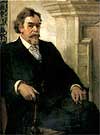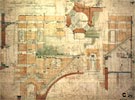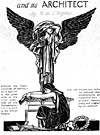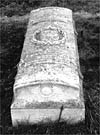John Francis Bentley: Cathedral Architect
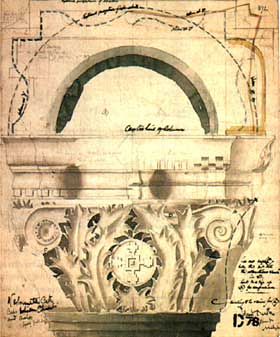
Bentley's drawings for a column capital.
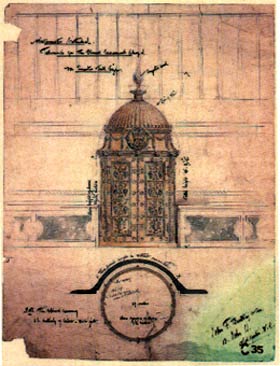
Drawing for the tabernacle in the Blessed Sacrament Chapel
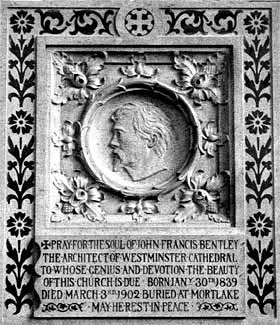
Memorial to John Francis Bentley in the Holy Rood Church, Watford.
‘Si monumentum requiris...’
John Francis Bentley, the architect of Westminster Cathedral, was born in 1839 in Doncaster and died on 2 March 1902.
In June 1900 the Royal Institute of British Architects (RIBA) held an Architectural Congress, and its first visit was to the incomplete Westminster Cathedral. It was a great success, and at the annual dinner Sir William Blake Richmond, RA (best known as designer of the mosaics of St Paul’s, and later to advise Bentley on mosaic decoration), declared that "he had very rarely been so impressed as when first entering that original and manly structure" two days previously.
However, the occasion was marred by the fact that, when Bentley was due to address the visitors, he "discovered that his tongue was powerless", and had to ask Canon Johnson to step in. This was the second attack of the paralysis caused by cancer of the tongue, which was to kill him.
Soon after the visit, a deputation from the RIBA called on Bentley to ask if he would accept nomination for its highest honour, the Royal Gold Medal. Because of the death of Queen Victoria in January of the next year, no medal was awarded, but in February 1902 it was announced that Bentley was to receive it. Always a loner, he had never even been a member of the RIBA, but he appreciated the honour since it came from "my confrères whose opinion I value...especially the men of thought, and those who are endeavouring to make architecture a living, not a dead, art."
His nomination was due to be confirmed on 3 March, but he died on the previous day. The new King’s advisers decided that, as the nomination had not been confirmed, and there was no precedent for a posthumous award, nothing could be done. When the RIBA built its new headquarters in Portland Place, in 1933-4, the left-hand wall of the entrance hall was inscribed with the names of Gold Medal winners (and they continue to be added). In 1952, the fiftieth anniversary of Bentley’s death, the Council of the RIBA decided that Bentley’s name should be carved on the polished limestone wall next to the panel containing the names of Gold Medallists (immediately to the left of the entrance). The person responsible for suggesting this was probably H S Goodhart-Rendel, himself an architect, and an active and devoted member of the Westminster Cathedral Art Committee. He was also a brilliant author, and in his English Architecture since the Regency (lectures given as Slade Professor at Oxford in 1934, published in 1953) he had praised Bentley to the skies, describing the Cathedral as "a work of extraordinary beauty and grandeur."
In November 1902 The Daily Chronicle reported that the RIBA was intending to erect a silver tablet in the Cathedral to commemorate Bentley. Its Secretary wrote (rather churlishly) to deny this, but Leonard Stokes explained that such a project was on foot among architects, and he thought it "an excellent idea." Stokes (1858-1926), who was himself to be President of the RIBA in 1910-12, was a Catholic, and his masterpieces include what is now the All Saints Pastoral Centre at London Colney. (His son David was also a member of the Cathedral Art Committee.)
The silver tablet was never erected. It is doubtful whether Bentley would have approved of the idea, since as early as 1886 he had expressed his dislike of "brass plates" in churches. His Gothic masterpiece, the Church of the Holy Rood at Watford, contains a stone tablet in his memory, erected by the donor of the church, Stephen Taprell Holland, and carved with a relief portrait by Henry McCarthy, the sculptor responsible for the effigy of Cardinal Vaughan in his Chantry (1907). He also has a memorial in his own parish church, St Mary’s, Clapham, where his widow paid for the erection of one of the two iron screens which he had designed shortly before his death for the north side of the sanctuary. Some have regretted the lack of a memorial in the Cathedral, but Bentley surely needs one no more than Wren at St Paul’s.
Some have thought that he should have been buried in the Cathedral. However, he found an appropriate resting-place in the grave of the two of his eleven children who had died before him, in the cemetery behind St Mary Magdalen’s Church, Mortlake. His tombstone, simple but elegant, was designed by John Marshall, his loyal assistant, who succeeded him as Cathedral Architect, and carved by Messrs Whitehead (whose shop-front can still be seen in Rochester Row).
Nearby at Mortlake are buried Henry Clutton, the architect to whom he had been articled in 1857-60, and who had made the first designs for a new cathedral for Cardinal Manning, and Fr H A Rawes, Superior of the Oblates of St Charles who, when Parish Priest of St Francis, Pottery Lane, had given Bentley his first independent commissions, enabling him to set up his own practice. Closer still are his eldest daughter Winefride, author of the magnificent two-volume "Westminster Cathedral and its Architect", and her husband Count Rene de l’Hôpital, member of a distinguished Huguenot family, and painter of the portrait of Bentley which hangs in Cathedral Clergy House. Sir Richard Burton, whose marble tent is the best-known feature of the graveyard, is a neighbour about whom Bentley might have felt more ambivalent.
Peter Howell
Mr Howell is a member of the Cathedral’s Art and Architecture Committee.
First published in Oremus, the magazine of Westminster Cathedral September 2000
Enjoy more articles from the Cathedral’s magazine by subscribing to Oremus.

